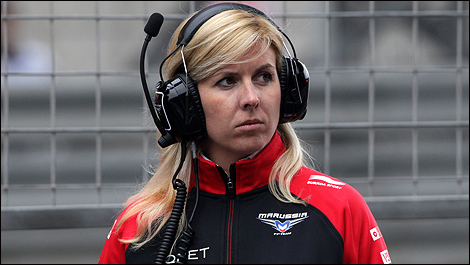Jul
19th
Stay connected Subscribe to our RSS feed
A few weeks ago, news of an accident suffered by Spanish driver, Maria de Villota, stunned the auto racing world.
At the beginning of the year, Marussia, a small Formula 1 team, announced that Maria, daughter of Emilio de Villota, himself a former independent Formula 1 driver, would be their test driver for the 2012 season.
While the young woman was quite experienced in competitive auto racing, she had never raced in a major series such as the GP2 or the Formula 3. Maria de Villota was surely not chosen based on her driving qualifications, but rather for her celebrity status and the media attention it would draw. Still, there is no doubt that she possessed all the necessary skills to get the job done.
The accident occurred at the Duxford Aerodrome in the UK during aerodynamic testing. While returning to the team service area after the high-speed test, the Marussia MR01 suddenly accelerated and, at a speed of around 60 km/h, collided with the back of one of the support trucks.
Poor Maria hit the truck's ramp helmet-first. She suffered serious head injuries and lost her right eye.
On Monday, July 16, the team released a carefully-worded statement declaring that Marussia's own detailed analysis shows that the accident was not caused by a technical malfunction.
In effect, this means that the Spanish driver must have made a mistake.
What happened? It's hard to know. Most probably, Maria forgot to put the car into neutral as she drove back to the pits at low speed. The F1's very complex electronic control unit has an anti-stall feature that electronically prevents the engine from stalling if the engine speed is too low.
And so, since the car was engaged, most probably in first gear, it accelerated abruptly. Having little time to react to a car that she barely knew, Maria had already collided with the truck before she could regain control. Don't forget, when the steering wheel is covered in buttons, switches and knobs, finding and pressing on the ‘N' button is not an easy thing to do in a tenth of a second, especially when you are manually controlling the clutch at the steering wheel and not with your foot...
We might also suspect that Marussia's in-depth search for a technical issue served to protect them against legal action by the driver's family and insurer, since legal action could ensue if the car was found at fault. But now, all responsibility rests on poor Maria's shoulders, who, after fighting for survival, is now slowly recovering from two major facial reconstruction surgeries.
Her short career is already over. Good luck, Maria.
At the beginning of the year, Marussia, a small Formula 1 team, announced that Maria, daughter of Emilio de Villota, himself a former independent Formula 1 driver, would be their test driver for the 2012 season.
While the young woman was quite experienced in competitive auto racing, she had never raced in a major series such as the GP2 or the Formula 3. Maria de Villota was surely not chosen based on her driving qualifications, but rather for her celebrity status and the media attention it would draw. Still, there is no doubt that she possessed all the necessary skills to get the job done.
 |
| Photo: WRI2 |
The accident occurred at the Duxford Aerodrome in the UK during aerodynamic testing. While returning to the team service area after the high-speed test, the Marussia MR01 suddenly accelerated and, at a speed of around 60 km/h, collided with the back of one of the support trucks.
Poor Maria hit the truck's ramp helmet-first. She suffered serious head injuries and lost her right eye.
On Monday, July 16, the team released a carefully-worded statement declaring that Marussia's own detailed analysis shows that the accident was not caused by a technical malfunction.
In effect, this means that the Spanish driver must have made a mistake.
What happened? It's hard to know. Most probably, Maria forgot to put the car into neutral as she drove back to the pits at low speed. The F1's very complex electronic control unit has an anti-stall feature that electronically prevents the engine from stalling if the engine speed is too low.
And so, since the car was engaged, most probably in first gear, it accelerated abruptly. Having little time to react to a car that she barely knew, Maria had already collided with the truck before she could regain control. Don't forget, when the steering wheel is covered in buttons, switches and knobs, finding and pressing on the ‘N' button is not an easy thing to do in a tenth of a second, especially when you are manually controlling the clutch at the steering wheel and not with your foot...
We might also suspect that Marussia's in-depth search for a technical issue served to protect them against legal action by the driver's family and insurer, since legal action could ensue if the car was found at fault. But now, all responsibility rests on poor Maria's shoulders, who, after fighting for survival, is now slowly recovering from two major facial reconstruction surgeries.
Her short career is already over. Good luck, Maria.
 The latest auto news, reviews, prices, product and vehicle releases.
The latest auto news, reviews, prices, product and vehicle releases.